#juvenile king penguins
Explore tagged Tumblr posts
Text

An adult king penguin hunts for its chick amongst a sea of similar-looking 'oakum boys' (juvenile king penguins) on the Island of South Georgia in Antarctica.
By Paul Nicklen
#paul nicklen#photographer#king penguins#penguins#oakum boys#juvenile king penguins#bird#south georgia#antarctica#nature
60 notes
·
View notes
Note
Hello Sora!
Have you seen pictures of Pesto, the Juvenile Emperor Penguin who is taller than most adults and 10 kg heavier than his parents? I know he’s a different species from Birgil, but how would he react to seeing him?

Ooooo I saw him on the news! He is a huge king penguin chick, can’t wait to see his form after moulting! I like that he waddles with quite an attitude and has a big appetite.(*ˊ˘ˋ*) (Birgil can relate)
Below is Birgil’s comment:

Thank you for the question, Muzz!
Have a nice day!
72 notes
·
View notes
Text
Hello hi friend (@knight-says-nanana) recently made this post referencing our conversation on Jervis Tetch having Wonderland nicknames for everyone but with actual Meaning to it, and I am here to share my List of them
Edward Nygma/Riddler - Dormouse
Not only could he physically resemble a dormouse (Shorter, they tend to have reddish brown/Orange coats I think?), but again, it's more about the sleepiness. The Dormouse is depicted as asleep/Always falling asleep, and only really waking up to correct Alice. Jervis's likely first or longest first meeting with Ed would be in Arkham. Arkham, where his cell has been shown to have "Keep sedated" on it
Jonathan Crane/Scarecrow - March Hare
A hare matches Jon's aesthetic. Long gangly creepy looking bunny. Typically depicted with straw on his head. It's cute if Jervis refers to him as "My dear Hare". March Hare and Hatter are friends!
And also the Hare is routinely depicted as nerve wrecked or delirious, and in adaptations, often dies or suffers
Harley Quinn - Queen of Hearts
The red and black look, the cards aesthetic already there. Plus, Queen of Hearts is childish, bad tempered, quick to overreact, very feared character (Also has a mallet). And also rarely Actually executed people. This one does play on the negatives more, due to the fact she's an antagonist (More obstacle for Alice to clear) But the queen Does have some better traits
Selina Kyle/Catwoman - Cheshire Cat
Obvious, only major cat themed rogue, but Does have deeper implications. Cat dissapears often and without a trace, seemingly or literally invisible, can go places most do not dare to. And also friendly with both the protagonist and antagonist characters. Inherently chaotic neutral force. It does what it wants for it's own entertainment. It may like Alice and act sorta as a guide sometimes, but that in no way means it sticks on her side
Hugo Strange - Gryphon
Somewhat overbearing, dismissive of the obsession and Sorrow of other characters, says they have no fact. Orders around Mock Turtle. This may not fit the greatest, but I like it
The Batman - The Jabberwock
Some unknown and all around feared cryptid? Yeah makes sense
Oswald Cobblepot/Penguin - Dodo
Flightless bird depicted with a cane. Odd, but good natured. Mostly. Does try to burn down a house as a solution to Alice being stuck in it. Organizes the Caucus races. The Dodo character/Races are meant as a critic on systems that lack clarity and decisiveness, who's actions are ultimately unhelpful or pointless
Now there are a couple I'm not entirely sure about yet. It's actually suprisingly hard to make everything fit well
Victor Fries/Mr. Freeze - White Rabbit
Because. He. Y'know. Is running out of time? I do like this one, mostly cause it's a lil funny to me. And also Freeze is mostly only an antagonist to work for his goal, the Rabbit is only "antagonist" Because he has to work for the Queen
Basil Karlo/Clayface - Mock Turtle
Melancholic, sad that it's no longer a real turtle/Just a turtle
Pamela Isely/Poison Ivy - King of Hearts/The Flowers
She is So hard to pin down. I could say Kimg of Hearts to match Harley (Moderate, calm, the one that pardons the subjects, calms the queen, later revealed just as juvenile and willing to execute), or, I could go with the flowers to match her vibe. I really do not know
Waylon Jones/Killer Croc - Jabberwocky/Duchess
Kinda hate both of these for him. Jabberwock because. The obvious. Duchess kinda due to starting off nice to the queen, then transitioning to friendly and respectful with Alice. Major temper (Nervously agressive) but not inherently bad even though she starts/Is Queen aligned?
Harvey Dent/Two Face - Tweedle Dee & Dum/The Walrus & The Carpenter
Tweedle Dee and Dum seem like the obvious answer but I kinda hate it so much. It doesn't feel like it fits and kinda feels insulting. Nothing Truly fits Two Face. Walrus and Carpenter is the closest I got. Walrus (Two Face?) The leader, conniving moocher, con man, yet hopeful of the future. Carpenter (Harvey?), believes getting an honest job will be better, still goes along with the plan, acts before he thinks, quick to anger
Joker - King of Hearts/Knave of Hearts
King to match Harley but also I dislike most adaptations so mm. Knave because he's a coward/j
#i am so insane about hatter#i could do him better#we could do him better#stop making him an incel/creep/pedo it does Not fit the story he's emulating#jervis tetch#mad hatter#mad hatter dc#edward nygma#the riddler#jonathan crane#the scarecrow#harley quinn#selina kyle#catwoman#hugo strange#batman#oswald cobblepot#the penguin#mr. freeze#killer croc#clay face#poison ivy#two face#dc#batman rogues
52 notes
·
View notes
Text
National Wildlife Photo Contest: Bright Spots.
I picked the photos I liked best. Click/tap on the caption to see the others.
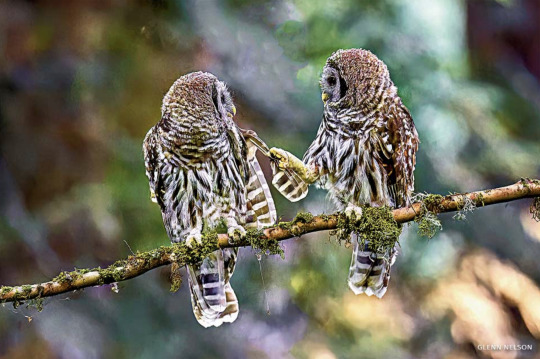
BABY ANIMALS, First Place, Glenn Nelson, Seattle, Washington.
Nelson identifies with these juvenile barred owl siblings, declared invasive in the Pacific Northwest. A lifelong U.S. citizen born in Japan, “my community was forcibly removed from about the same habitat [as the owls] for merely resembling the enemy during World War II,” he says. Nelson sees the owls, photographed in July 2023, as “charismatic fauna that open people to relationships with other beings and nature.”
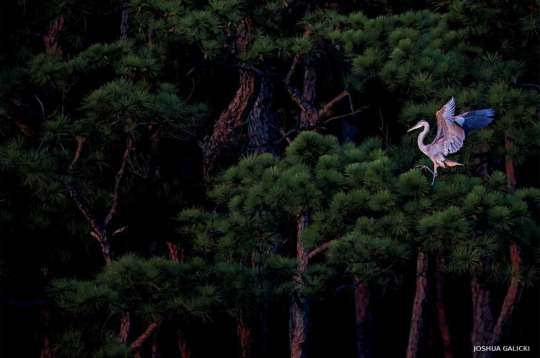
BIRDS, First Place, Joshua Galicki, Claiborne, Maryland.
Both Galicki and his subject, a great blue heron, were poised at the right place and the right time to preserve this moment of subtle beauty: Galicki from his kayak in a cove near his home on the Chesapeake Bay and the heron about to grasp a loblolly pine branch on shore. “The sun was setting, and a few last rays of light touched the heron at a fantastic angle,” he says of the July 2023 image.

LANDSCAPES & PLANTS, Second Place, Nancy Hajjar, Lone Pine, California.
The “beautiful swirling orange lenticular cloud” captured by Hajjar of Funchal, Portugal, in April 2021 only looks otherworldly. Lenticular clouds—formed by air flowing over high mountain ranges, such as California’s eastern Sierra Nevada—are frequently compared to, and sometimes mistaken for, flying saucers.
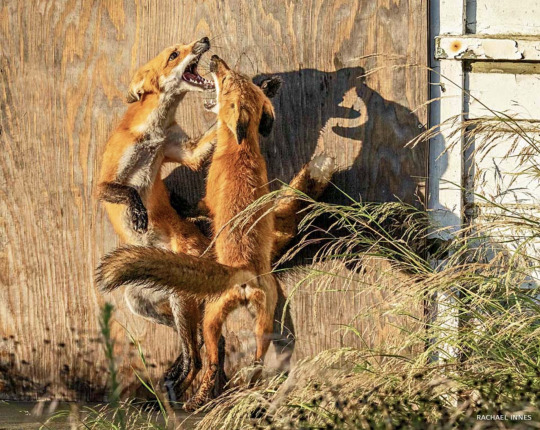
MAMMALS, First Place, Rachael Innes, San Pedro, California.
“I was fortunate to be able to follow an urban fox family from the day the kits emerged until they left to start their own lives,” says Innes of Torrance, California. In this August 2023 photo, she captured two red fox kits—and their shadows—playing at an old coast guard station in San Pedro, near the foxes’ cliffside den.
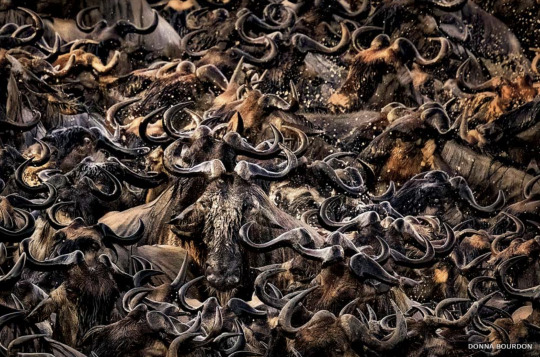
MAMMALS, Second Place, Donna Bourdon, Maasai Mara, Kenya.
Bourdon of Decatur, Tennessee, observed four days of wildlife river crossings in Kenya in September 2023, including a roughly 10,000-strong throng of wildebeests and zebras. “Once the first wildebeest made the leap of faith, the entire herd pushed forward, and there was no turning back,” she says. Above, a sole wildebeest faces her camera head-on, waiting its turn to ascend the far bank of the river, even as “the risk of being trampled and drowned is extremely high.”
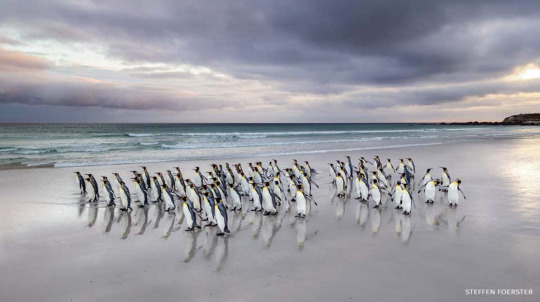
MOBILE, First Place, Steffen Foerster, Falkland Islands.
When Foerster of Sunnyside, New York, saw a colony of king penguins about to pass him on a Falkland Islands beach in December 2023, he had professional camera equipment at his fingertips. And yet, he reached for his cell phone with its ultrawide lens “for a much more expansive scene”—a split-second decision that caught “an unforgettable experience.”
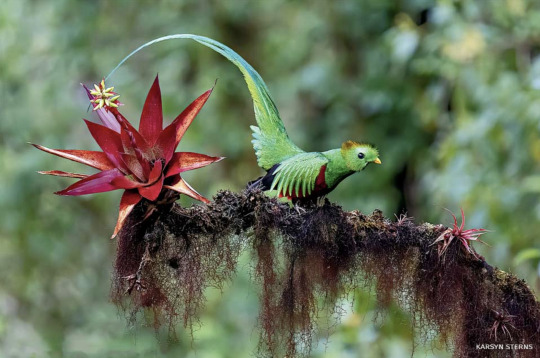
YOUNG NATURE PHOTOGRAPHERS, First Place, Karsyn Sterns, San Gerardo de Dota, Costa Rica.
Talk about a story arc: Accompanied by her dad, 13-year-old Sterns traveled to Costa Rica in March 2023 from her home in Dumfries, Virginia, with the goal of observing the aptly named resplendent quetzal. “I was especially happy to have seen and photographed this bird,” she says. We say, mission accomplished.
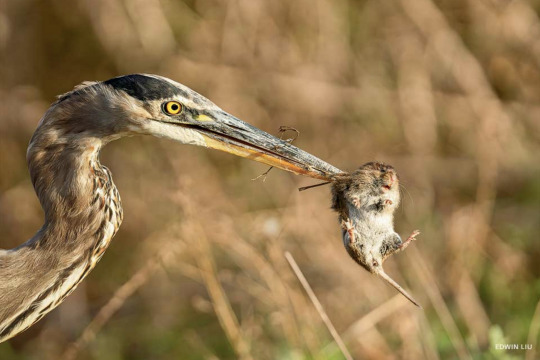
YOUNG NATURE PHOTOGRAPHERS, Second Place, Edwin Liu, Mississauga, Canada.
A friend told the budding photographer Liu, 17, that a great blue heron fished every evening in a Mississauga park. When Liu visited in October 2023 but didn’t see the bird within an hour, he grew restless and abandoned the park pond, only to encounter the bird in the bordering farmland. Ten minutes later, he watched the heron catch a vole. “When the heron hunts, it is indeed more patient than the photographer,” Liu says.

PORTFOLIO, First Place, Sonny Parker, Yukon, Canada.
While Dall sheep—native to alpine pockets of northwestern North America, from Canada’s British Columbia, Northwest Territories and Yukon up into Alaska—have evolved to stave off a host of predators, they now face a different threat: a rapidly changing climate. In the past, events such as lambing were timed precisely to optimal conditions, but as seasons become less predictable, “the sheep are struggling to stay synchronized,” says Parker, who lives in Haines Junction, Canada. In photos from May 2021 to January 2024, Parker documented the sheep throughout the year, including during winter, when the animals’ dense fur keeps them warm in temperatures as frigid as 40 below zero degrees F.
3 notes
·
View notes
Text
i love how utterly fucking abysmal The Wild (2006) is. it's a horrible movie, and not even in a fun way. it's agony to watch. literally don't watch this movie. it's like. okay hold on.
so we all know how Disney's business plans worked in the late nineties to mid oughts, right? here's the big three:
appeal to the teens. because, ysee, word on the cool cat street was that disney just wasnt jivin with those rad hip youngsters, the teens. this was because then-CEO michael eisner learned his teenage son thought disney was like, soooo whatever. so in order to appeal to a wider demographic that potentially had money to spend on disney, Eisner would purposefully have things appeal to teens. or, at least, a 40-year-old's idea of what teens were like in the 1970s.
one-up Dreamworks Pictures. any disney fan will tell you that Michael Eisner and Jeffery Katzenberg were BEEFING, and this was reflected in the Disney-Dreamworks feud, not LEAST of which was that Dreamworks was created because Katzenberg was passed up for CEO in favor of Eisner.
jealousy. the most famous examples of this are Disneyland's California Adventure (a famously California-themed area in the California Disney park in the middle of the California-themed California) and Animal Kingdom (an entire third zoological park built just thirty minutes away from the famously safari-themed Busch Gardens (complete with live giraffes!) in Tampa, FL). if someone else did an idea, Eisner would try to have Disney do it better.
we caught up on that? good. most of you will be pointing something out by now: Eisner left disney in late 2005! The Wild was released in 2006! there's literally no way he could have been involved! which, ignoring how long movies take to make, COULD make this whole thing not an issue... except for one little event that happened in 2005. a little Dreamworks movie that was taking america by storm. the little-known snuff film... Madagascar (2005), released by Dreamworks to insane success. kids LOVED Madagascar, they loved King Julien, they loved the funny talking animals, they loved the use of old songs for fun interstitial plot beats, and they ESPECIALLY loved those silly little spy penguins. critics thought it was juvenile, however, so Madagascar now sits at a middling, but still positive, 55% critical reception on RT.
for a fun game, imagine for yourself what The Wild, released by Disney in 2006, could have a rating of. Go ahead, without looking it up, guess. we'll come back to that.
now, what i'm saying here isn't substantiated and the timeline doesn't exactly work, but hear me out. The Wild was often criticized for ripping off not only similar to Madagascar, but also The Lion King. Disney and Dreamworks's little pissing contest wasn't exactly subtle, and Eisner's jealousy when he saw how that stupid little animal movie was going over like gangbusters would've been enough for him to greenlight a similar idea, but with that little disney twist. and then he left, like a rat on a ship.
let's discuss the plot of The Wild.
we hear Samson the Lion start with telling someone a story about a previous fight he had had in The Wild, which is apparently just Africa. the logo is happening, yknow with the little firework line making an arc over the castle? except the much-younger teenage son then keeps interrupting by saying he's heard this story, and the firework keeps getting pulled back to the start in Comedic Fashion. the story is about how Samson, who apparently has sonic fucking roars, sent a bunch of wildebeests flying into the horizon, but then they had a big beefy furry wildebeest in the background who was like 46 feet tall. the son, Ryan the Lion, says he can feel the roar coming up, and Samson tells him to let loose, and Ryan does an alley cat soundbite because they didn't want to go to the Central Park Zoo and record actual lion cub noises.
By the way, this movie IS, in fact, opening in the Central Park Zoo. because we couldn't be more obvious. Samson the Lion is appropriately very famous, but not more famous than Nigel the Koala (voiced by Eddie Izzard), who is the basis of "the most popular doll in america", a pullstring plush koala that has two phrases: "I'm so cuddly; I like you!" and "I'm having a really nice day!". anyways, similar to madagascar, when the Central Park Zoo closes for the night, all the animals just get out and mingle. every single animal has a very distinct accent for some reason, as well??
anyways we're at this point introduced to the other main characters and their running jokes: Benny the Squirrel, whose joke is that he can't take a fucking hint; Bridgette the Giraffe, who is every sitcom woman in one and the unwilling target of Benny's affections; Nigel, who is extremely surly and the worst character in the movie; and Larry, a burmese python whose running gag is that he's stupid but sometimes he says something smart.
i'd like to just take an aside here to tell you all that Larry, despite being the idiot comic relief, ended up being my favorite character in the entire movie because the movie keeps forgetting he's supposed to be stupid?? like he'll just keep being very observant, but because every so often he'll drift into a nonsequitor all of his friends will angrily tell him to shut the fuck up, but it's like - bro he's the only one who's making sense. like at the end of the movie he puts forward an idea and before anyone can respond he goes "yeah, yeah, i know, shut up Larry :(" and it's like. bro get better friends.
anyways through a wacky series of events, Ryan's attempts to stop his friends from causing a Gazelle stampede cause the gazelles to stampede, and despite all of Ryans efforts to stop the stampede he caused, they run through the Turtle Curling competition the Samson is trying to win, costing Samson the Big Game, which means we gotta have Samson and Ryan having a big fight. i should mention that Ryan is insecure that he can't roar despite literally being prepubescent, and Samson is just like "are you acting up all because you can't roar?!" like DUDE THAT IS YOUR SON AND HE IS EIGHT. HIS VOICE HASN'T EVEN CRACKED YET.
Ryan then runs off to the green shipping crates that are being sent to New York's Harbor, and Samson and Benny go off to save Ryan after the workers somehow fucking miss the lion cub sleeping in broad fucking daylight. the dynamic duo is then joined by Bridgette (who knocks Benny off the truck), Nigel, and Larry. we then get a montage set to, and i am not fucking kidding, Clocks by Coldplay, where the animals experience the mysteriously-empty Times Square for the first time. more uhhhhh Wacky Hijinks ensue, and the rescue party are too late to get onto the cargo ship heading to africa, so they COMANDEER A PONTOON and tail the ship - after Benny rejoins them.
and here's where it gets to the point where i realized this movie was trying TOO hard to be dreamworks. if you'll recall, dreamworks likes to sneak in adult jokes, like famously Shrek looking at Duloc and going "do you think he's compensating for something". yknow, little innuendos like that.
Benny, having ridden in on a flock of Canadian Geese that mysteriously vanish after this scene after being hired as navigators, turns to Bridgette and, in an attempt to flirt with her, says that he's an expert goose rider, and that he rides bareback, and then slaps his flank.
it was becoming clear to me that every character was slowly becoming unmanageable to feel sympathy for.
after what would be, realistically, a few months - much too long for a pontoon to remain fueled, and WELL too long for a ship with passengers and sans supplies to remain populated, they reach the shores of Africa, which is... well it's not the shores of Madagascar, despite it literally being exactly like that scene in Madagascar where the animals are beholden to the rich jungles of madagascar. but for some reason this area of Africa not only has rich jungles, but ALSO an ACTIVE VOLCANO centrally located in the jungle. this is the purpose of the green transport crates: the wild animals are being rescued from an impending eruption. this is never brought up, but Ryan confuses the situation despite spending LITERAL MONTHS on that ship and potentially- actually
now that i'm writing this out, HOW DID NO ONE ON THE FUCKING SHIP. NOTICE THEY HAD AN ADOLESCENT LION CUB ON THE- THEY WERE SUPPOSED TO BE EMPTY CRATES. THEY WOULDN'T HAVE. NOTICED THE. LION CUB???? PROBABLY MEWLING FOR HELP???? IN A CONTAINER WITH OPEN-AIR WINDOWS????? BRO????
anyways Ryan runs into The Wild, and Samson and friends run after Ryan but lose him somehow. Samson, whose main character trait is that everyone else is saying that he always talks about being a real child of the Wilderness (notice that Samson himself never backs this up), eventually comes clean about his past after a scene with a hyrax that goes WAY too long in anyone's opinion - Samson was sold to the zoo after being raised in the circus. Samson was Ryan's age, as in like eight years old, when he was forced to attempt to roar in front of an audience, and when he couldn't because he was eight, he was SOLD TO THE ZOO. and his father's parting words were "if you had been born in the wild, you would have been able to roar" LIKE SIR YOUR SON IS STILL A CHILD DOMESTICATION DOESN'T MEAN YOU CAN'T FUCKING- HELLO???
anyways everyone treats this as some Big Betrayal, and Samson goes off on his own to find Ryan. meanwhile Nigel gets kidnapped by wildebeests.
yes, there are wildebeests living in this fucking jungle.
Nigel is then brought to the ACTIVE VOLCANO, where the WILDEBEESTS HAVE STARTED A DEATH CULT. they are led by William Shatner Wildebeest whose name i have forgotten because despite being the main antagonist he was revealed fifty minutes into a seventy-minute movie. turns out, one of those Nigel dolls fell off of a cropduster plane over this nondescript african jungle, interrupting a lion hunt against this wildebeest despite the fact that neither of these animals live in the jungle. the pullstring then scared the lions into fleeing, and Shatbeest took this as an OMEN FROM GOD to START A DEATH CULT where ALL WILDEBEESTS WILL BECOME CARNIVORES AND ALL LIONS WILL BECOME HERBIVORES. also he made a whole song out of the "I'm having a really nice day!" voiceline complete with choreography. this is somehow not only plot important but also instrumental in his downfall.
anyways Nigel immediately gets drunk with power because he has no morals and is the worst character in the movie.
the wildebeests kidnap Bridgette and Larry and knock Benny out. have you noticed Benny just keeps getting put offscreen so he can solve the plot later? anyways Samson hallucinates dr seuss colors because he's activating his "predator instincts" to find his cub, which - red flag - but it also works. and then the wildebeests kidnap ryan after throwing Samson off a cliff, and you would not believe how much i wanted him dead so the movie would be over.
it was around this time that i realized i would much rather watch cars 2 again. my girlfriend had long since admitted that.
Benny wakes up in the middle of a bunch of German scarabs (who are all like. yodelling milkmaid types?????) who thought he was shit, and tbh yeah good call, but anyways Benny wakes up Samson who is somehow completely unharmed from being dropped off a cliff with an entire tree on top of him. Samson then has a tangible hallucination pointing them to the volcano, which he and Benny both see.
Nigel meanwhile actually has to weigh the pros and cons of siding with the wildebeests and watching them cook and eat his friends, or saving his friends. Shatbeest meanwhile REALLY wants to eat a LITERAL COWERING CHILD.
outside the volcano, we find out that Samson's hallucinations are a LITERAL LEGION OF SECRET AGENT CHAMELEONS who are trying to get people to defeat the wildebeests - which, like, WHY DID YOU NEED THESE TWO YOKELS???? YOU'RE LIKE. THERE'S A WHOLE JUNGLE OF POORLY-PLACED ANIMALS. THERE ARE OTHER LIONS IN THE JUNGLE SURELY. WHAT HAPPENED TO THE LIONS IN THE FLASHBACK??
anyways the chameleons can make benny and samson invisible by covering them and going transparent. obviously.
the finale is incredibly like. it's such a nothing finale. the chameleons barely factor into it?? like Benny and Samson are just suddenly there, and Shatbeest keeps physically overpowering Samson and later Ryan, but Shatbeest angers the other wildebeests because one of them couldn't get the choreography right and so he's kicked towards the sacrifices as one of them. and then Ryan is like "aw dad... i wish you had the father i had. :(" which like. WHEN was it explained to you what happened with your dad. you were JUST told that your dad was born in captivity you don't know WHAT HAPPENED you just IMMEDIATELY went to being mean to him. and that inspires the wildebeests to turn on Shatbeest because this is the lion king so we gotta have that hyenas eat scar scene. but then the volcano, the LITERAL ACTUAL VOLCANO EVERYONE'S BEEN INSIDE OF THIS WHOLE TIME, starts to erupt, and Shatbeest is crushed under rocks.
everyone gets to the pontoon, and Samson, Ryan, the group, the wildebeests, and for some reason the chameleons all escape just as the island erupts, and it's like, fuck all the other bitches right? anyways then we have a heartfelt moment immediately undercut by the animated movie dance party ending where Nigel the koala just starts twerking. Benny stops being sexist out of complete nowhere despite never learning his lesson and this is completely undercut by Bridgette kissing him and revealing she was into being objectified this whole time, she just wanted Benny to be Woke about it. every single character in this movie was awful (except Larry i just feel bad for him) and in my mind the movie ends with that fucking pontoon sinking in the middle of the atlantic for exceeding its weight limit.
it's such a nothing movie. every scene feels like it's from something else. my girlfriend maintains that everyone who defends this movie is a corporate shill. my experience with this movie was i watched it multiple times as a kid, and i had somehow convinced myself this WASN'T a disney movie and was instead made by one of those low-budget studios that makes a single animated film before vanishing forever. it feels like a parody of itself, like someone had made a prior movie that doesn't exist that they then warped with ten consecutive funhouse mirrors.
it feels like michael eisner's teen son tried to make madagascar but Edgy.
and now we come back to the fun game from before the cut. what was the number you came up with on rotten tomatoes? what would rotten tomatoes rate this movie that has effectively been scrubbed from disney's records? Madagascar has 55%, what could its ugly step-reflection be?

...well that's not good.
16 notes
·
View notes
Text
[Image ID: Tweet from Cosmic (octopus emoij) Slop (@/afroCosmist) on 2024-09-22 reading: no shade to Moo Deng or Pesto the massive king penguin chick but i think some sort of juvenile mollusk or larva should get its 15 minutes of fame /End ID]

8K notes
·
View notes
Text
St. Andrews Bay, South Georgia Island. Dec. 27, 2024. Part 5.
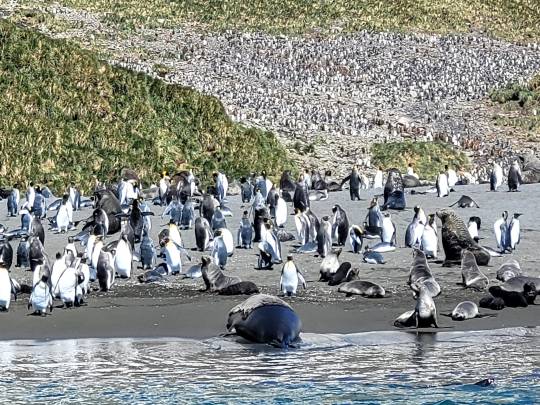
St. Andrews Bay has a King Penguin colony of 100,000 birds. They nest way up the hill as far as you can see. When you think of them traveling that distance, up hill, taking 3 inch steps. Then try and find their one chick to feed. It boggles the mind.
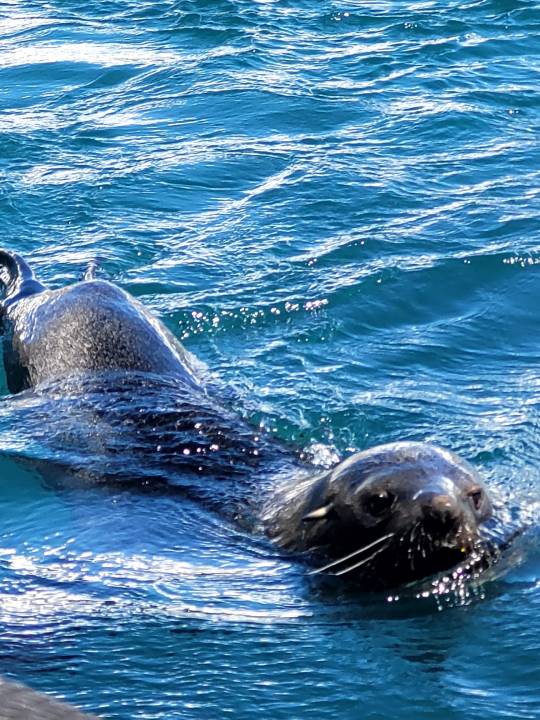
Here a friendly fur seal checks out our zodiac on our way to the beach.
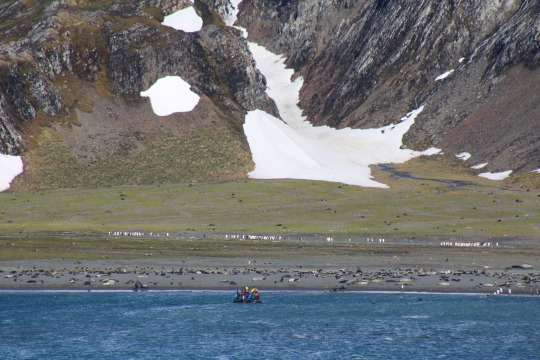
We landed to the far right side of the main colony. Even then it was problematic to stay 15 feet from the fur and elephant seals. The black dots way up the hill are fur seals.
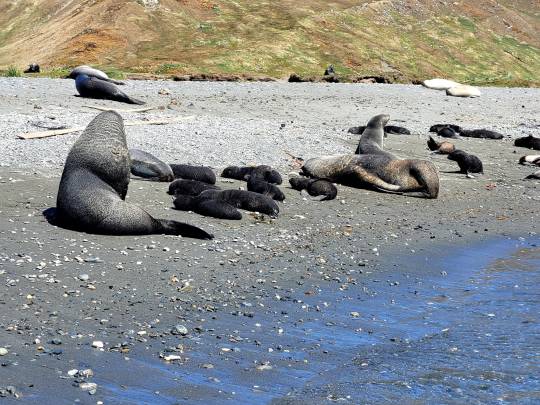
We make a successful wet landing. The Expedition guides had surveyed a path for us to follow. We are supposed to generally walk near the red flags they plant. Orange cones denote a dead seal. We have to stay 30 feet from the dead carcass. No complaints from me!
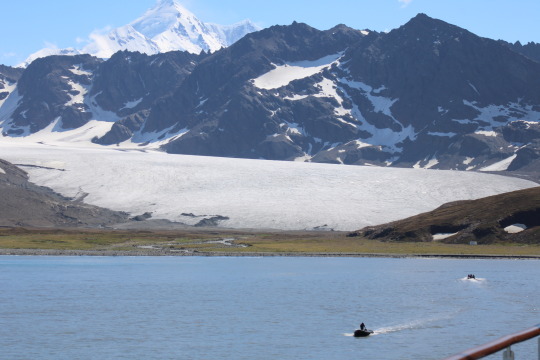
St. Andrews’s Bay is famous for the huge Penguin colony and the three glaciers that empty into the bay. David Attenborough has been here several times documenting the glacier retreating. During his first visit in the 60’s he could barely pass the glacier face on the beach. Now it has retreated back several miles.
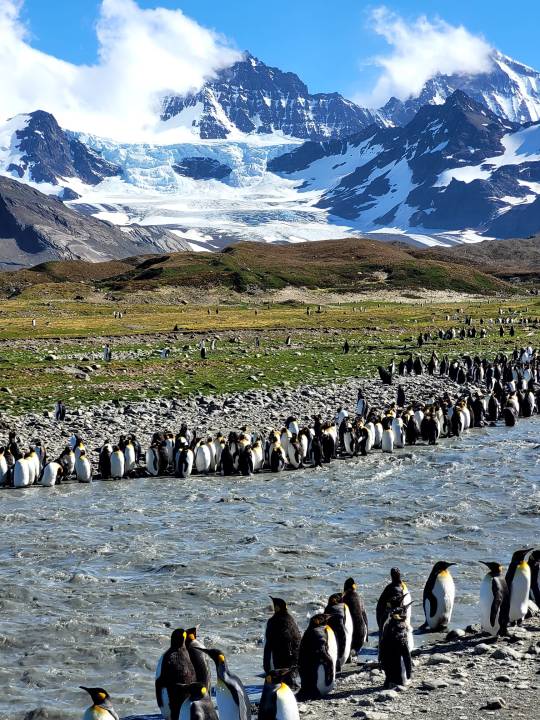
Glacial run off cuts the colony up. Most of these are juveniles and should stay out of the ice cold water.
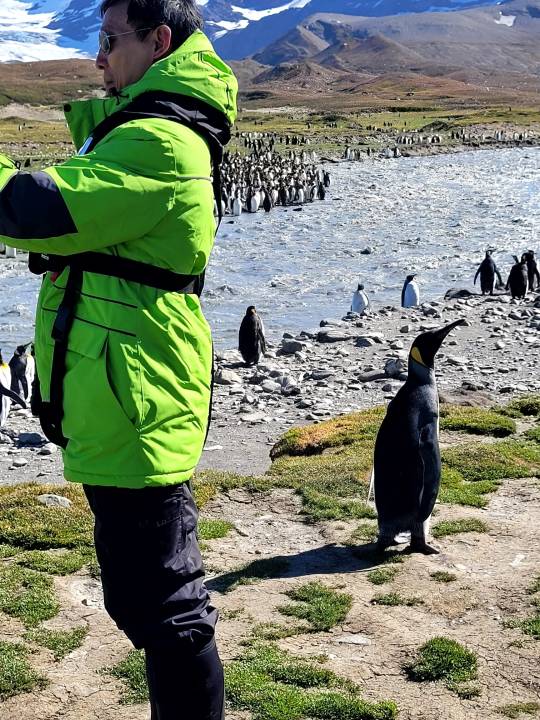
If you are not paying attention a King Penguin will walk right by you.
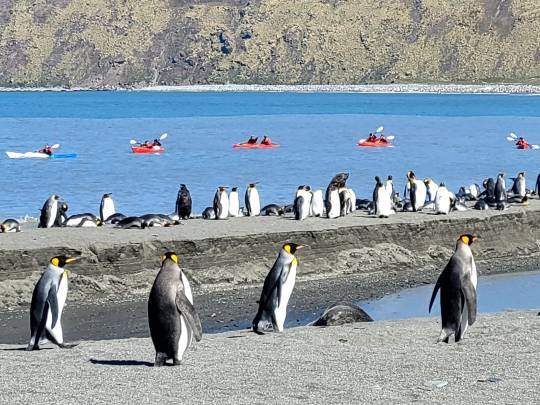
Here a group of kayakers from the ship pass down the shoreline. During one kayak trip, a fur seal jumped on the back of a kayak. Then looked over the shoulder of the guy paddling from the back of the kayak.

The juvenile King Penguins are even more comical looking during their molt.
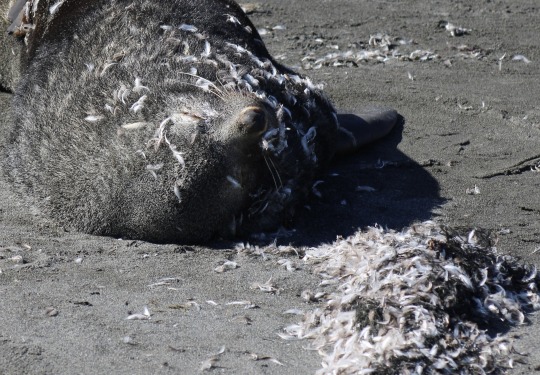
The white penguin feathers fly around like a snow storm. Here is an oblivious fur seal taking a nap.
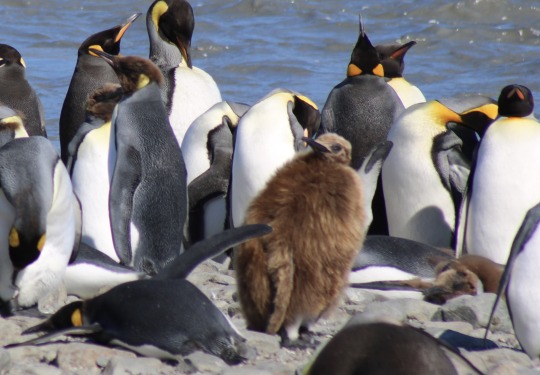
The brown chicks are really young King Penguins. This guy was on a small island in the glacial stream. It had a cold swim to get here.
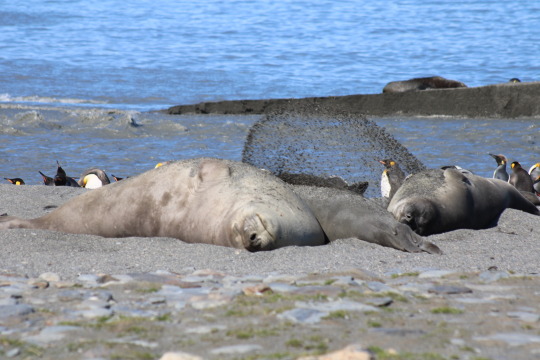
Here is a “wallow” of elephant seals. One guy is throwing sand over himself and his neighbors.
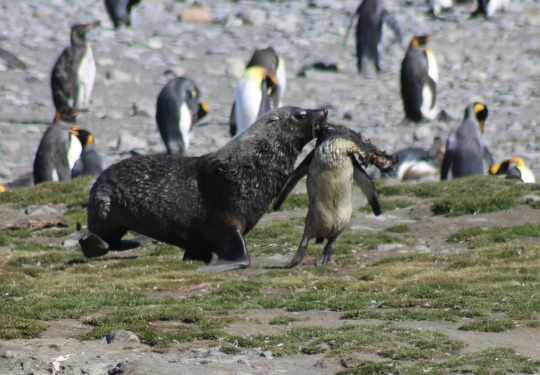
Here a young fur seal has killed a King Penguin and ran down the beach 50 yards. He would drop the penguin, then chase any other fur seal in his path. Retuning to grab the dead penguin and run some more. Although fur seals will eat a penguin. It is usually done as a last resort. In this case it was explained that more than likely, it was a young male which was having raging hormones and acting out.
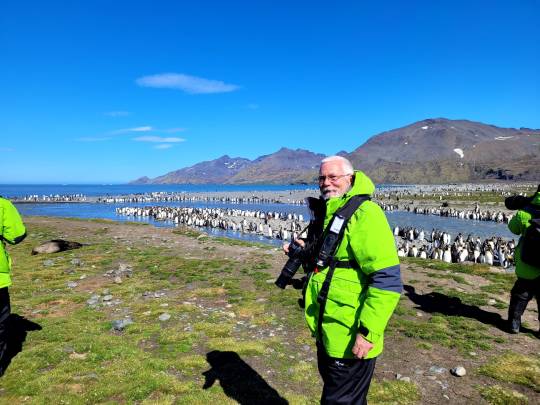
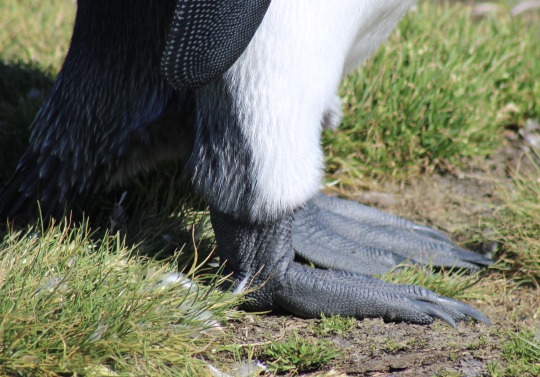
Try walking a mile uphill with these short legs.
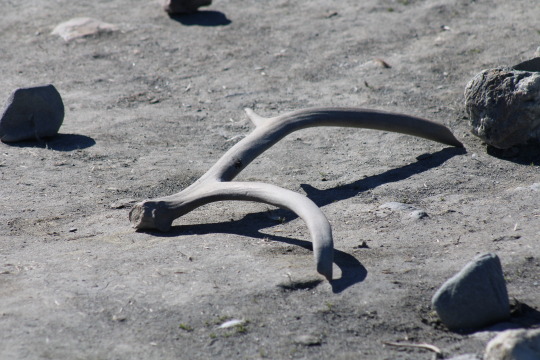
The Norwegian whalers introduced Reindeer to the island in the early 1900’s. There is an eradication program in effect. It is thought that all Reindeer have been exterminated. Is this antler a historical artifact or recently dropped?
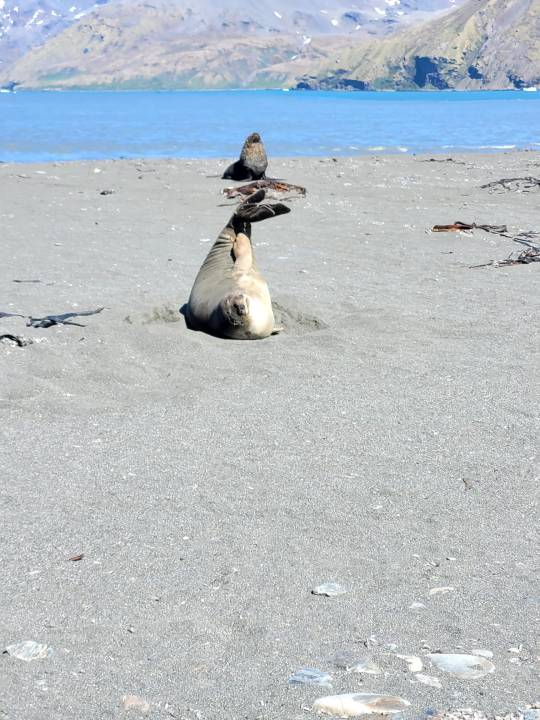
Elephant seal yoga!

King Penguins are beautiful.
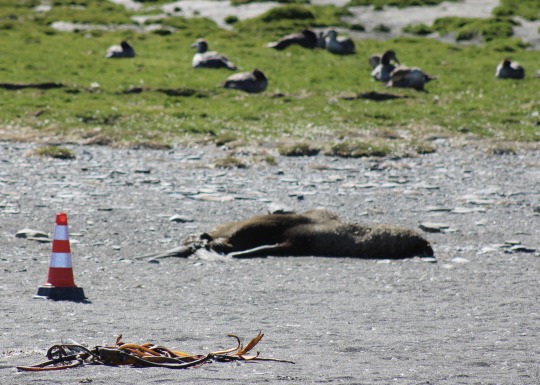
Here the orange cone denotes a dead seal. The skua birds will pick the bones clean.
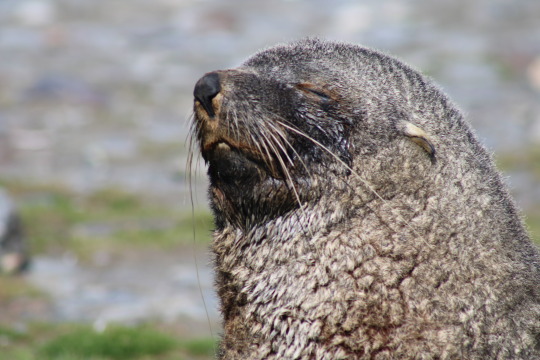
Here is a fur seal up close, they are easily recognizable by their ears.
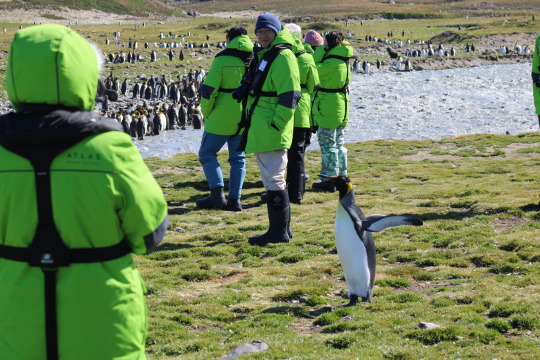
Out of the way! Penguin coming through!
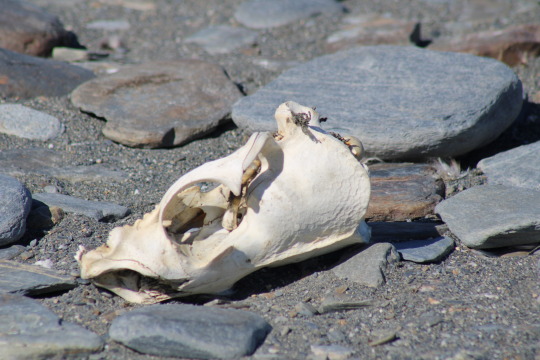
Seal skull.
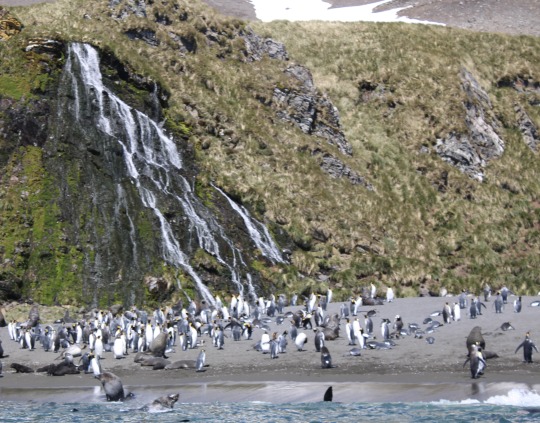
Due to the massive amount of penguins, we could only walk a quarter mile. So we returned to the zodiacs for a “zodiac cruise” down the coast.
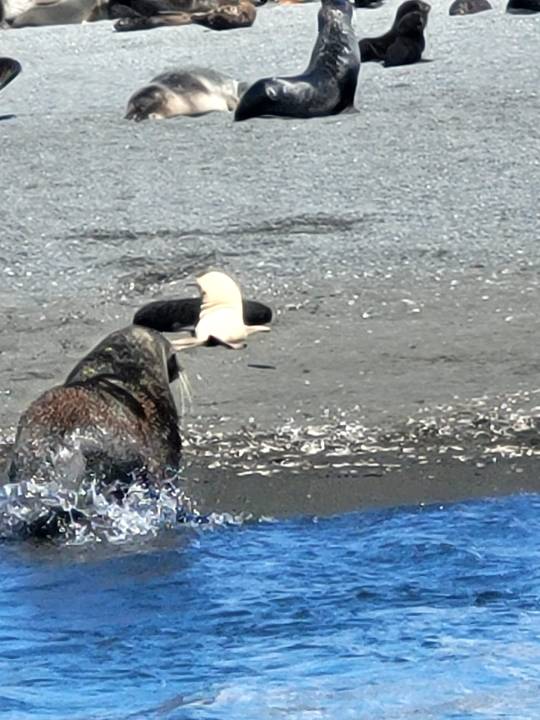
On the left side of the photo is a “blond” Fur seal pup. These are not albinos, just a totally blond fur. This happens in about 1 out of 800 births.
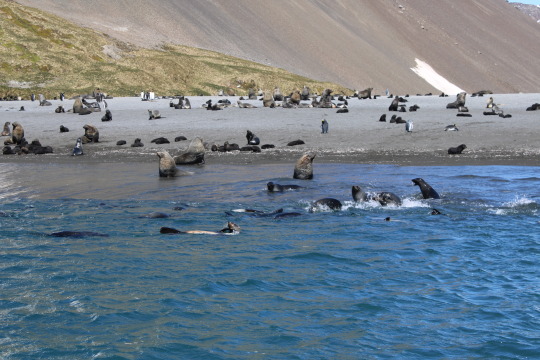
The water is alive with penguins and seals frolicking.
This is one of our top two sites we visited, due to the amount of wildlife that we could get close to. You could spend a day here watching this. It was like a constant 3 ring circus, times ten. Everywhere you looked something was going on. Penguins were walking right by us. Juveniles posing in their hilarious molting stages.
0 notes
Text


King penguin - this little piss baby was named when it was believed to be the biggest penguin (biggest is actually the emperor penguin). ive included images throughout all their stages of growth to showcase the hideous in between phase a penguin experiences as it transitions from juvenile to adult known as the catastrophic molt. the king penguin's maturity cycle often lasts up to 14 months, far longer than most other penguins.

their status is least concern and they have an estimated population of around 4.5 million.
9/10 penguin. their auricular patches, the rich golden spots on the backs of their heads, astronomically increase their score. the definitive elegant tuxedo penguin.
1 note
·
View note
Text
I would like to offer this resource for therians, an extensive list of all of Sir David Attenborough’s nature documentaries that are available on soap2day, and a full list of what species* they each (notably, prominently) feature the natural behaviors of, separated by episode, and omitting species that were only shown dead, juvenile or being predated on. This took me a while (I have been working on it since Prehistoric Planet’s release) because I did in fact have to watch every single series in full in order to list all the species and the episodes are around 50 minutes long, but enjoy.
Long post ahead:
Most of these shows have closed captioning, which is why I’ve picked soap2day. Planet Earth is the only one that doesn’t. I did not include Dynasties and Dynasties II because each episode only features one species.
Thank you to Birch (@ambiguousmutt) for his help (he watched about half of the episodes) so I didn’t have to do it individually. Credit goes to him as well.
*Sometimes Attenborough doesn’t say the specific species and I was too busy trying to get through the episodes to identify it. In those cases I just put the most specific name I could.
Planet Earth
Episode one (From Pole to Pole): emperor penguin, polar bear, caribou, arctic grey wolf, Amur leopard, six-plumed bird-of-paradise, superb bird-of-paradise, great white shark, African elephant, African buffalo, lechwe, baboon, African wild dog
Episode two (Mountains): gelada, walia ibex, Ethiopian wolf, guanaco, cougar, grizzly bear, markhor, snow leopard, golden eagle, grey wolf, panda, golden snub-nosed monkey, red panda, demoiselle crane
Episode three (Fresh Water): giant salamander, grizzly bear, smooth-coated otter, Nile crocodile, dolphin fish, midge, Amazon river dolphin, dorado, piranha, spectacled caiman, crab-eating macaque, snow goose
Episode four (Caves): wrinkle-lipped free-tailed bat, cockroach, bat hawk, cave swiftlet, yellow-red rat snake, Texas blind salamander
Episode five (Deserts): Bactrian camel, dromedary camel, red kangaroo, fennec fox, guanaco, long-nosed bat, Nubian ibex, flat lizard, lion, African elephant, locust
Episode six (Ice Worlds): snow petrel, Antarctic petrel, south polar skua, humpback whale, emperor penguin, eider, muskox, arctic grey wolf, polar bear, little auk, arctic fox
Episode seven (Great Plains): Mongolian gazelle, red-billed quelea, wildebeest, snow goose, arctic fox, arctic grey wolf, bison, wild ass, Tibetan fox, pygmy hog, African elephant, lion, baboon
Episode eight (Jungles): magnificent bird-of-paradise, spider monkey, howler monkey, siamang gibbon, gliding tree frog, colugo, red crab spider, African elephant, chimpanzee
Episode nine (The Shallow Seas): humpback whale, multiple corals, banded sea krait, trevally, dugong, bottlenose dolphin, Socotra cormorant, salp, comb jelly, sea lion, dusky dolphin, sea urchin, sunflower starfish, short-tailed stingray, great white shark, king penguin, fur seal
Episode ten (Seasonal Forests): Eurasian lynx, moose, crossbill, wolverine, western capercaillie, pine marten, great grey owl, pudu, kodkod, mandarin duck, cicada, red deer, Amur leopard, tiger, mouse lemur
Episode eleven (Ocean Deep): whale shark, oceanic whitetip shark, common dolphin, Cory's shearwater, manta ray, sea spider, vampire squid, spider crab, unnamed deep sea eel, giant isopod, chambered nautilus, Pacific spotted dolphin, mola mola, frigatebird, sailfish, blue whale
Planet Earth II
Episode one (Islands): pygmy three-toed sloth, Komodo dragon, sifaka, marine iguana, Galapagos racer, Buller's albatross, fairy tern, Christmas Island red crab, yellow crazy ant, chinstrap penguin
Episode two (Mountains): Nubian ibex, red fox, golden eagle, grizzly bear, bobcat, flamingo, mountain viscacha rat, snow leopard
Episode three (Jungles): spider monkey, flying lizard, sword-billed hummingbird, river dolphin, jaguar, glass frog, paper wasp, click beetle, red bird of paradise, Wilson's bird of paradise, indri
Episode four (Deserts): lion, Harris's hawk, shrike, locust, sand grouse, pale chanting goshawk, feral mustang, golden mole, desert long-eared bat, darkling beetle, Namaqua chameleon
Episode five (Grasslands): saiga antelope, lion, harvest mouse, carmine bee-eater, Kori bustard, African elephant, serval, Jackson's widowbird, grasscutter ant, compass termite, giant anteater, bison, red fox, arctic grey wolf
Episode six (Cities): langur, peregrine falcon, leopard, European starling, great bowerbird, raccoon, rhesus macaque, spotted hyena, wels catfish
Our Planet
Episode one (One Planet): lesser flamingo, orchid bee, golden-collared manakin, red-capped manakin, blue manakin, cormorant, booby, common dolphin, shearwater, African wild dog, timber wolf
Episode two (Frozen Worlds): gentoo penguin, wandering albatross, narwhal, Pacific walrus, humpback whale, orca, leopard seal, polar bear
Episode three (Jungles): lowland gorilla, forest elephant, black sicklebill, twelve-wired bird-of-paradise, western parotia, mountain treeshrew, Philippine eagle, black spider monkey, leafcutter ant, Sumatra orangutan, velvet worm
Episode four (Coastal Seas): northern fur seal, compass jellyfish, giant trevally, mobula ray, Atlantic stingray, bottlenose dolphin, grey reef shark, whitetip reef shark, sea otter, California sheephead wrasse, Steller's sea lion, bald eagle, humpback whale, Guanay cormorant, Inca tern, Peruvian booby, South American sea lion
Episode five (From Deserts to Grasslands): Socotran cormorant, Arabian leopard, Arabian oryx, African elephant, cheetah, bison, Alcon blue butterfly, saiga, Przewalski's wild horse, tiger
Episode six (The High Seas): blue whale, spinner dolphin, mobula ray, oarfish, anglerfish, bristle worm, giant petrel, black-browed albatross, wandering albatross, bluefin tuna, sea lion, humpback whale
Episode seven (Fresh Water): Australian pelican, torrent duck, grizzly bear, manatee, giant mayfly, common kingfisher, osprey, jaguar, callipterus cichlid, Siamese fighting fish, hippopotamus, lion, African elephant, sandhill crane
Episode eight (Forests): Siberian tiger, bald eagle, rough-skinned newt, great hornbill, African elephant, African wild dog, fossa, gray mouse lemur
A Perfect Planet
Episode one (Volcano): lesser flamingo, marabou stork, Galápagos land iguana, vampire ground finch, Aldabra giant tortoise, North American river otter, coyote, Kamchatka brown bear, wildebeest
Episode two (The Sun): yellow-cheeked gibbon, fig wasp, arctic grey wolf, wood frog, garter snake, arctic fox, Saharan silver ant, golden snub-nosed monkey, sooty shearwater, humpback whales
Episode three (Weather): straw-colored fruit bat, fire ant, Amazonian giant river turtle, desert rain frog, Bactrian camel, Christmas Island red crab, carmine bee-eater, Nile crocodile, African fish eagle, hippopotamus
Episode four (Oceans): common dolphin, marine iguana, flightless cormorant, flamboyant cuttlefish, eider, bottlenose dolphin, lemon shark, manta ray, blacktip reef shark, trevally, rockhopper pengin, Eden's whale
Episode five (Humans): none
Life
Episode one (Challenges of Life): bottlenose dolphins, cheetah, panther chameleon, orca, brown-tufted capuchin, stalk-eyed fly, hippopotamus, Clark's grebe, giant Pacific octopus, strawberry poison-dart frog, leopard seal, orangutan
Episode two (Reptiles and Amphibians): pebble toad, caiman, basilisk, Brazilian pygmy gecko, panther chameleon, Namaqua chameleon, red-sided garter snake, collared iguana, hog-nosed snake, horned lizard, sea krait, African bullfrog, Komodo dragon
Episode three (Mammals): Weddell seal, elephant shrew, aye-aye, caribou, straw-colored fruit bat, lion, spotted hyena, polar bear, brown-nosed coati, meerkat, African elephant, humpback whale
Episode four (Fish): sailfish, flying fish, weedy sea dragon, convict fish, sarcastic fringehead, mudskipper, Hawaiian freshwater goby, hippopotamus, barbel, silvertip shark, clownfish, sea lion, ragged tooth shark, multiple snapper, whale shark
Episode five (Birds): spatuletail hummingbird, lammergeier, red-billed tropicbird, magnificent frigatebird, red knot, horseshoe crab, lesser flamingo, chinstrap penguin, great white pelican, Clark’s grebe, sage grouse, Vogelkop bowerbird
Episode six (Insects): Darwin’s beetle, unnamed damselfly, monarch butterfly, alkali fly, Wilson’s phalarope, oogpister beetle, mongoose, bombardier beetle, honey bee, black bear, Japanese red bug, Dawson’s bee, grass cutter ant
Episode seven (Hunters and Hunted): ibex, short-tailed stoat, brown bear, Ethiopian wolf, California ground squirrel, star-nosed mole, cheetah, red fox, greater bulldog bat, bottlenose dolphin, Bengal tiger, rattlesnake, orca
Episode eight (Creatures of the Deep): Pompeii worm, Humboldt squid, nemertean worm, moon jelly, fried egg jellyfish, spider crab, stingray, cuttlefish, giant Pacific octopus, sunflower sea star, king crab, cleaner shrimp
Episode nine (Plants): monarch butterfly, purple-throated carib hummingbird
Episode ten (Primates): Hamadryas baboon, Japanese macaque, lowland gorilla, spectral tarsier, phayre's leaf monkey, ring-tailed lemur, Sumatra orangutan, chacma baboon, white-faced capuchin, brown-tufted capuchin, western chimpanzee
Blue Planet II
Episode one (One Ocean): bottlenose dolphin, tuskfish, tern, giant trevally, mobula ray, false killer whale, Asian sheepshead wrasse, orca, humpback whale, walrus
Episode two (The Deep): sea toad, Venus’ flower basket, unnamed shrimp, ethereal snailfish, cock-eyed squid, pyrosome, barrel-eyed fish, unnamed siphonophore, yeti crab, Humboldt squid, fangtooth fish, sixgill shark, scabbardfish, zombie worm
Episode three (Coral Reefs): broadclub cuttlefish, coral grouper, day octopus, multiple corals, green turtle, bottlenose dolphin, manta ray, bobbit worm, saddleback clownfish, marbled grouper, grey reef shark
Episode four (Big Blue): spinner dolphin, yellowfin tuna, mobula ray, sailfish, sperm whale, sea turtle, blue shark, great white shark, multiple jellyfish, Portuguese man o' war, whale shark, wandering albatross, shortfin pilot whale
Episode five (Green Seas): Garibaldi, Australian giant cuttlefish, weedy seadragon, common octopus, pyjama shark, sea otter, tiger shark, smooth stingray, zebra mantis shrimp, common dolphin, humpback whale
Episode six (Coasts): Pacific leaping blenny, king penguin, southern elephant seal, Sally Lightfoot crab, Galápagos sea lion, ochre starfish, clingfish, chain moray eel, Atlantic puffin, arctic skua
Episode seven (Our Blue Planet): none
Prehistoric Planet
Episode one (Coasts): Tyrannosaurus rex, Tethydraco, Phosphatodraco, Tuarangisaurus, Mosasaurus hoffmannii, pycnodont fish, ammonites, Kaikaifilu
Episode two (Deserts): Dreadnoughtus, Tarbosaurus, Velociraptor, Mononykus, Barbaridactylus, Secernosaurus
Episode three (Freshwater): Velociraptor, Tyrannosaurus rex, Deinocheirus, Quetzalcoatlus, Masiakasaurus, Beelzebufo, elasmosaur
Episode four (Ice Worlds): dromaeosaur, hadrosaur, Ornithomimus, Olorotitan, troodontid, Antarctopelta, Pachyrhinosaurus, Nanuqsaurus
Episode five (Forests): Austroposeidon, Triceratops, Carnotaurus, Qianzhousaurus, Edmontosaurus, Atrociraptor, Anodontosaurus, Therizinosaurus, Telmatosaurus, Hatzegopteryx
The Hunt
Episode one (The Hardest Challenge): African leopard, African wild dog, Parson’s chameleon, nose-horned chameleon, African mantis, Darwin’s bark spider, Nile crocodile, Amur falcon, orca, cheetah
Episode two (Arctic): polar bear, arctic grey wolf, arctic fox, glaucous gull
Episode three (Forests): tiger, American marten, sparrow hawk, Portia spider, tarsier, harpy eagle, chimpanzee, army ant
Episode four (Oceans): blue whale, frigatebird, dorado, sargassum fish, spinner dolphin, Beroe ovata, Chiroteuthis, lionfish, black-browed albatross, sea lion, tuna, copper shark, common dolphin, Bryde's whale
Episode five (Plains): cheetah, caracal, honey badger, termite, bald eagle, lion, Ethiopian wolf, hotrod ant, spoor spider
Episode six (Coasts): bottlenose dolphin, algae octopus, sand bubbler crab, long-tailed macaque, marine otter, grizzly bear, grey wolf, peregrine falcon, orca, humpback whale
Episode seven (Conservation): none
Life In Colour
Episode one (Seeing In Color): Indian peafowl, mandrill, Costa’s hummingbird, magnificent bird-of-paradise, blue moon butterfly, fiddler crab, mantis shrimp, flamingo, poison dart frog
Episode two (Hiding In Color): Bengal tiger, langur, ptarmigan, crab spider, zebra, Cuban painted snail, blue-striped fangblenny, common waxbill, pin-tailed wydah, Augrabies flat lizard
Frozen Planet II
Episode one (Frozen Worlds): emperor penguin, orca, Pallas’s cat, Siberian tiger, grizzly bear, hooded seal, polar bear
Episode two (Frozen Ocean): polar bear, beluga, harp seal, skeleton shrimp, crested auklet, orca
Episode three (Frozen Peaks): high-casqued chameleon, japanese macaque, kea, andean flamingo, giant panda, golden eagle, andean mountain lion
Episode four (Frozen South): king penguin, Antipodean wandering albatross, blue whale, Weddell seal, chinstrap penguin, snow petrel, leopard seal, orca
Episode five (Frozen Lands): grey wolf, arctic fox, Amur leopard, Siberian tiger, painted turtl, Lapland bumblebee, snowy owl, caribou, grizzly bear
Episode six (Our Frozen Planet): none
Africa
Episode one (Kalahari): fork-tailed drongo, ostrich, black rhinoceros, Angolan giraffe, African leopard, armored ground cricket, spider wasp
Episode two (Savannah): Agama lizard, shoebill, bee-eaters and rollers, lesser flamingo, African elephant, crowned eagle, African fish eagle, martial eagle
Episode three (Congo): chimpanzee, central African rock python, Angola banana frog, African skimmer, rockfowl, African elephant
Episode four (Cape): emperor swallowtail, giant kingfish, African penguin, monkey beetle, springbok, yellow-billed kite, pied crow, ghost crab, vundu catfish, Nile crocodile, Bryde’s whale, great white shark, common dolphin
Episode five (Sahara): Grevy’s zebra, naked mole rat, barn swallow, Dromedary camel, dung beetle, crocodile, western yellow wagtail, Saharan silver ant
Episode six (The Future): none
548 notes
·
View notes
Text
Imagine being the beast pirate's mascot
King: we need to do something about whitebeard, he keeps sinking joker's supply ships.
Kaido: *goes out in to the balcony and stares out to sea* have Jack take an armada of the gifters and pleasures out to raid a few of Whitebeard's islands, that ought to stop them for a while, or at least long enough for us to set up a permanent escort for the ships. Sasaki and your unit, you'll go with Jack too.
Sasaki: *watching you in amusement* sure thing boss
King: very well, I'll ~ *stops midsentence because he spots you out in the snow* what the fuck are they doing?
You: *in the snowy courtyard below them shuffling your feet along like a penguin creating a strip what showed the grass below the snow*
Sasaki: dunno
Kaido: oh this ought to be good *leans on the banister and watches you*
Jack: I think they're spelling something, "ur"?
Sasaki: *snorts when you fall face first into the snow*
Kaido: no no, I see it! "Ur... Moms”?
King: that probably isn't good for the grass
Queen: it's gonna die with the snow anyway.
Kaido: what's "ur... Moms.. ahoe?"
King: *sighs* "your mom's a hoe" of course (y/n) would be that juvenile.
You: *admiring your work* hehe, nice
Kaido: oh wohorororo! Very clever (y/n)
You: I didn't see you up there! This isn't what it looks like!
Kaido: wohororororo, it looks like you're having fun in the snow!
You: then it's exactly what it looks like!
Jack: why do we keep them around again?
Kaido: *can't believe he has to explain this* because they liven the place up
King: it is boring without them around.
Sasaki: you haven't been around long enough to remember what it was like before (y/n) joined, but it was dull before. They inspire a playfulness and camaraderie in people, you never know what's going to happen with (y/n) around.
Kaido: which makes them good for morale, you have a lot to learn brat *smacks jack upside the head*
Queen: oooohhh Jack's in trouble hehe!

#one piece#one piece x reader#one piece imagine#one piece scenario#one piece kaido#kaido#jack the drought#queen the plague#sasaki#king the conflagration#beast pirates#animal kingdom pirates#from the depths of the dragon's hoard#tma original#1/26/22#no beta we die like men
308 notes
·
View notes
Text

A juvenile King penguin
King penguins (Aptenodytes patagonicus) are the second largest of the penguin species, after the Emperor penguin. Similar to other penguins, fully grown but unfledged chicks can appear to be larger than the adult birds. They were sometimes known as "woolly penguins" by the early explorers due to the thick brown down of the juveniles that look like wool from sheep. Female King penguins lay one pyriform white egg which is balanced on their feet covered with a flap of abdominal skin called the brood patch. The egg is incubated for around 55 days with both male and female sharing incubation in shifts of 6–18 days each. Upon hatching, chicks are born with only a thin covering of down and continue to be protected by the brood patch for another 30-40 days. After that time, they are large enough and better able to both keep warm and protect themselves from most predators.
📷 Roman Murushkin
https://35photo.pro/romanvm
Info sources: www.coolantarctica.com, wikipedia
30 notes
·
View notes
Text
this penguin is strange. it shares traits of both the king and emperor penguin, but looks dissimilar enough from either species to be definitively placed in either category. its auricular patch strangely covers its eyes, and it appears too short to be an emperor, or perhaps even to be a king, as it couldn't stand much higher than a person's thigh, and it couldnt be a juvenile as they dont gain their adult plumage until they're fully grown. whatever. i guess ill say its an emperor, just with some strange markings.
3/10 penguin. its weird smile irks me, and i dont understand what the artist was thinking with this almost-but-not-quite-real-but-also-realistic-looking design.

Coca Cola uses a unique advertising strategy showing the viewer how Coke can transport you to a more joyful and carefree place. With the use of the penguin it emphasizes how the beverage transcends cultural and demographic boundaries figuratively and literally. With coke's main message in their advertising campaigns of sharing a coke with someone, the penguin could represent how maybe if you share your coke with someone that person could steal one from you when you least expect it because of how addictive the drink is. In addition the penguin adds an element of humor while showing the confusion on the man who’s wondering where his drink went. The color blue is pronounced in the advertising showing that coke is enjoyable on a hot sunny day. The repetition of the humans in the ad shows how everyone is relaxing and enjoying themselves while making the viewer think that everyone that’s there probably has had a coke or probably going to when coming out of the water. The setting of the beach also showcases how accessible coke is showing the viewer that coke is the only best option to have when you want to quench your thirst on a hot summer day. With the color, humans, setting, and penguin the ad maintains unity through its consistency of those things. The ad also sparks curiosity to the Viewer wondering how did a penguin get there and how does the penguin know that coke is a good drink? With cokes many unique advertising strategies on always trying to sell you not just on the product but a feeling or experience, this advertising campaign has to be one of the best ones because not only do they advertise on relaxation but they also sell on how addictive their drink is by using the penguin to catch the viewer’s attention and realize that even animals like the bubbly drink.
6 notes
·
View notes
Text
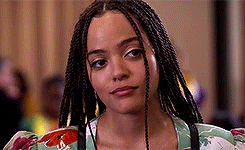
QUICK FACTS:
LEGAL NAME: Zari Thomas
NICKNAMES: Z, Riri
DOB/AGE: November 18th, 1997 (25 years old in November)
GENDER: NB
PRONOUNS: They/ Them/she/her
SEXUAL ID: Pansexual
HEIGHT: 5'6"
APPROXIMATE WEIGHT: 114 lbs.
LANGUAGES: English & Spanish
GLASSES/CONTACTS: N/A
TATTOOS/PIERCINGS: mother’s DOB on their side, cardinal on their left wrist, septum and nostril piercing
ALLERGIES:N/A
OTHER HEALTH ISSUES/DISORDERS:N/A
HOGWARTS HOUSE: Slytherin
FAITH/RELIGION/PHILOSOPHY: N/A
POSITIVE TRAITS (3): Intelligent, creative, charitable
NEGATIVE TRAITS (3): self-righteous, cynical, brash at times.
HOBBIES & ACTIVITIES: making music, drumming, having group sessions, staying healthy, charity work
LIKES/FAVORITES:
foods/cuisine- Ramen, sushi, Thai food
movie genres– horror, romance flicks
flower– red roses
snacks– Takis, sour cream and onion potato chips, Nerds
music genres–Rock; alt, punk, grunge pop rock , classical
season– Fall
book genre– horror, suspense
animal– Penguins
candy– Nerds, Skittles, M&Ms
BIOGRAPHY (TW: Drug abuse, addiction, illness)
Zari was born in the Bronx, NYC, and moved to California with their father after their mother passed away from a stroke. They moved in with their father’s parents. They were 8 years old. They had started acting out after leaving NYC and had gotten into the wrong crowds in high school where they met Frankie King and immediately became their friend but spiraled into addiction and dealing. Zari picked up the drums in high school and has been playing since. They have a band called Thorned Lips.
Zari ended up incarcerated for getting into a giant fight in school that resulted in their opponent getting severely and permanently injured. That got them expelled and in a juvenile detention. This strained the relationship with their father and after losing that support, Zari knew it was time to wake up. They got their GED while in Juvi and attended university upon their release. After their release, Zari moved in with a now clean Frankie who helped them also come clean and supported their college career. Zari is now a non-denominational pastor and counselor for troubled youth and works closely with their community. Their involved in many charities and in events to keep the community green. Zari is big on their health and meditation and very self-aware of how important it is to stay on the right path.
They had a fall out with Frankie before Ship-Wrecked, harboring feelings they had for their best friend and insulting their career and choices. This caused them to fall apart completely and they are no longer on speaking terms.
Zari is a pastor at The House of Compassion and also counsels troubled youth.
2 notes
·
View notes
Text
Eudyptula minor
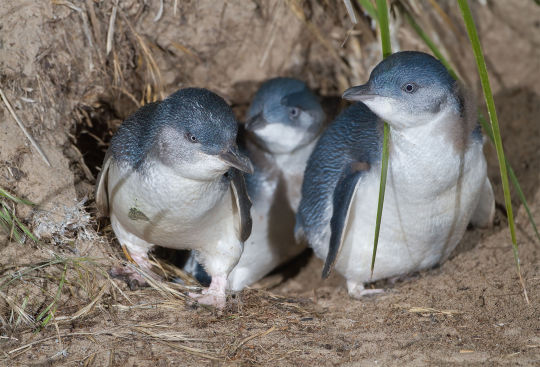
By J. J. Harrison, CC BY-SA 3.0
Etymology: Good Diver
First Described By: Bonaparte, 1856
Classification: Dinosauromorpha, Dinosauriformes, Dracohors, Dinosauria, Saurischia, Eusaurischia, Theropoda, Neotheropoda, Averostra, Tetanurae, Orionides, Avetheropoda, Coelurosauria, Tyrannoraptora, Maniraptoromorpha, Maniraptoriformes, Maniraptora, Pennaraptora, Paraves, Eumaniraptora, Averaptora, Avialae, Euavialae, Avebrevicauda, Pygostaylia, Ornithothoraces, Euornithes, Ornithuromorpha, Ornithurae, Neornithes, Neognathae, Neoaves, Aequorlitornithes, Ardeae, Aequornithes, Austrodyptornithes, Sphenisciformes, Spheniscidae
Status: Extant, Least Concern
Time and Place: From 12,000 years ago until today, in the Holocene of the Quaternary


Little Penguins are known from the coast of Australia and New Zealand
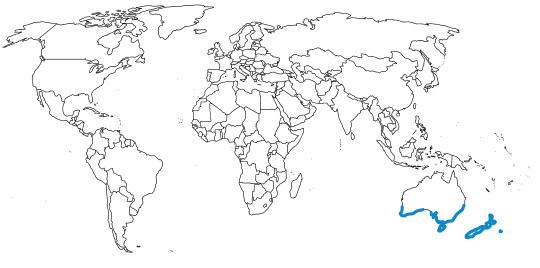
Physical Description: Little Penguins are some of the most adorable penguins alive today, and the reason is clear: they’re smol! Little Penguins range in size between 40 and 45 centimeters in length, and none weigh more than 2.1 kilograms. They are a blue-grey on their backs and white on their bellies and necks. They have very small flippers, which can be entirely blue or blue only in the center with white banding around it. They have short little tails and small feet, which are formed into lightly orange flippers. Their beaks are short and round, and either light in color or dark depending on the population. The juveniles tend to be a somewhat duller color than the adults, but usually very similar overall.
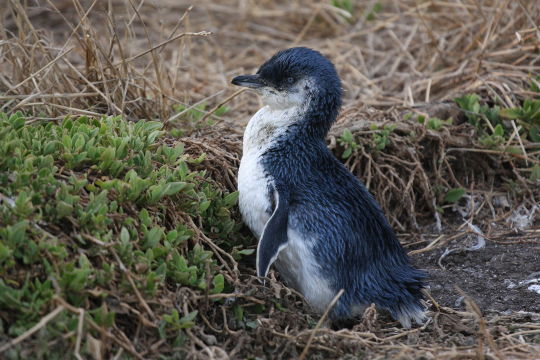
By Magnus Kjaergaard, CC BY 3.0
Diet: Little Penguins feed mainly on fish that form schools in the pelagic zone of the ocean (rather than closer to the coast). They’ll also feed on cephalopods and crustaceans.
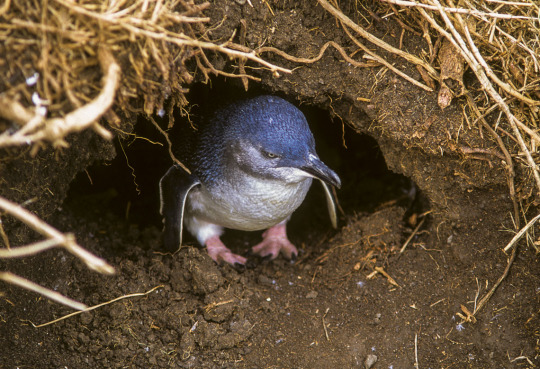
By Francesco Veronesi, CC BY-SA 2.0
Behavior: These nocturnal penguins will capture their food via pursuit-diving, mainly swimming around schools of fish in tighter and tighter circles until finally - woosh! - they dive into the middle and grab as much food as they can. In shallower water, they do pursue the fish more directly. They can dive as deep as 50 meters underwater, sometimes more - including 69 meters deep. They go up to 62 kilometers away from the nesting and sleeping colony sites, though they can usually only go a fraction of that in a single day and longer distances are reserved for multiple day trips. Females tend to forage more than the males. They feed alone, though they do forage in groups. They are extremely noisy in their colonies, making a variety of trills, brays, growls, grunts, yelping, trumpeting, and wailing sounds to one another. They do not migrate, but do stay near the breeding colony extensively during the moulting and nesting season. Juveniles will leave the colony for a large amount of time, but do eventually return to breed where they were born.
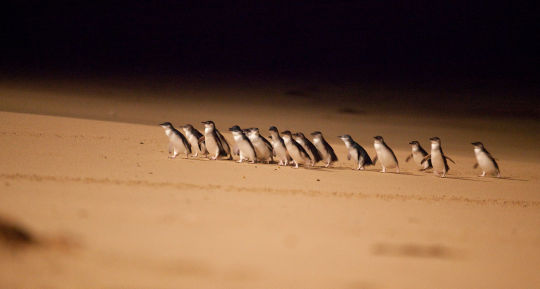
By Phillip Island Tourism, CC BY-SA 4.0
Little Penguins begin breeding in July and continue through December, though it varies from colony to colony and from year to year. They tend to stick to one nest site for their whole lives and are also fairly monogamous, though they do divorce from their partners around 76% of the time. If they are unsuccessful in raising any chicks one year, the next year they are more likely to divorce than not. The nests are made in a little bit far apart from one another in the colonie, usually a burrow in the sand lined with plant material. Usually two eggs are laid in the nest and are incubated for a little more than one month by both parents. The chicks hatch extremely fluffy and greyish-brown; they then molt to look dark brown and grey another month later. At this time young birds will form creches together for two more months, hanging out and learning from each other. They then fledge and become juveniles two more months later. They become sexually mature at two to four years of age, and can live for up to 20 years (though shorter is more common). The chicks and nesting colonies tend to feed at dusk.

By Mark Nairn, CC BY 3.0
Ecosystem: Little Penguins live mainly in sandy and rocky coasts, usually near the bases of cliffs and in sand dunes. They will spend most of their time in temperate to sub-arctic marine waters, many miles offshore. They are preyed upon by cats, dogs, rats, foxes, lizards, snakes, ferrets, stoats, seals, and some other ocean predators. They are mostly affected by introduced mammalian predators at this time.
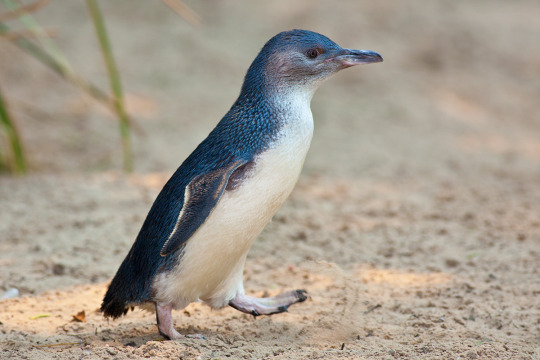
By fir0002, GFDL 1.2
Other: While Little Penguins are, overall, doing alright and are even common in terms of population management; however, a number of human-created threats are affecting certain colonies and bringing many of them to the verge of collapse. Uncontrolled hunting by domesticated dogs and cats are major causes of colony destruction, as are oil spills, fishing interactions (including being caught in nets), human interference and development, as well as cullings by humans attempting to manage populations of other birds. As such, Little Penguins are of major interest for ecological groups in order to preserve their populations in light of these threats. Fossils of this species are known from its current range from the recent ice age.
~ By Meig Dickson
Sources Under the Cut
Baird, R. F. 1992. Fossil avian assemblage of Pitfall Origin from Holocene sediments in Amphitheatre Cave (G-2), South-western Victoria, Australia. Records of the Australian Museum 44:21-44.
Banks, Jonathan C.; Mitchell, Anthony D.; Waas, Joseph R.; Paterson, Adrian M. (2002). "An unexpected pattern of molecular divergence within the blue penguin (Eudyptula minor) complex". Notornis. 49 (1): 29–38.
Bethge, P; Nicol, S; Culik, BM & RP Wilson (1997) "Diving behaviour and energetics in breeding little penguins (Eudyptula minor)". Journal of Zoology 242: 483-502.
Boessenkool, S., J. J. Austin, T. H. Worthy, P. Scofield, A. Cooper, P. J. Seddon, and J. M. Waters. 2009. Relict or colonizer? Extinction and range expansion of penguins in southern New Zealand. Proceedings of the Royal Society B 276:815-821.
Carroll, R. L. 1988. Vertebrate Paleontology and Evolution 1-698.
Chiaradia, A., Forero, M. G., Hobson, K. A., and Cullen, J. M. (2010) Changes in diet and trophic position of a top predator 10 years after a mass mortality of a key prey. – ICES Journal of Marine Science, 67: 1710–1720.
Clements, J. F., T. S. Schulenberg, M. J. Iliff, D. Roberson, T. A. Fredericks, B. L. Sullivan, and C. L. Wood. 2017. The eBird/Clements checklist of birds of the world: v2017.
Flemming, S.A., Lalas, C., and van Heezik, Y. (2013) "Little penguin (Eudyptula minor) diet at three breeding colonies in New Zealand". New Zealand Journal of Ecology 37: 199–205.
Fordyce, R. E. 1991. The Australasian marine vertebrate record and its climatic and geographic implications. In P. Vickers-Rich, J. M. Monaghan, R. F. Baird, T. H. Rich (eds.), Vertebrate Palaeontology of Australasia 1165-1190.
Grosser, Stefanie; Burridge, Christopher P.; Peucker, Amanda J.; Waters, Jonathan M. (2015-12-14). "Coalescent Modelling Suggests Recent Secondary-Contact of Cryptic Penguin Species". PLOS ONE. 10 (12): –0144966.
Grosser, Stefanie; Rawlence, Nicolas J.; Anderson, Christian N. K.; Smith, Ian W. G.; Scofield, R. Paul; Waters, Jonathan M. (2016-02-10). "Invader or resident? Ancient-DNA reveals rapid species turnover in New Zealand little penguins". Proceedings of the Royal Society B: Biological Sciences. 283 (1824): 20152879.
Littlely, Bryan (10 October 2007). "Fur seals threat to Granite Island penguins". The Advertiser. p. 23.
Martínez, I., Christie, D.A., Jutglar, F. & Garcia, E.F.J. (2019). Little Penguin (Eudyptula minor). In: del Hoyo, J., Elliott, A., Sargatal, J., Christie, D.A. & de Juana, E. (eds.). Handbook of the Birds of the World Alive. Lynx Edicions, Barcelona.
Numata, M; Davis, L & Renner, M (2000) "[Prolonged foraging trips and egg desertion in little penguins (Eudyptula minor)]". New Zealand Journal of Zoology 27: 291-298.
Rawlence, N. J., A. Kardamaki, L. J. Easton, A. J. D. Tennyson, R. P. Scofield and J. M. Waters. 2017. Ancient DNA and morphometric analysis reveal extinction and replacement of New Zealand’s unique black swans. Proceedings of the Royal Society B 284:20170876.
Rodríguez, A., Chiaradia, A., Wasiak, P., Renwick, L., and Dann, P.(2016) "Waddling on the Dark Side: Ambient Light Affects Attendance Behavior of Little Penguins." Journal of Biological Rhythms 31:194-204.
Saraux, Claire; Chiaradia, Andre; Salton, Marcus; Dann, Peter; Viblanc, Vincent A (2016). "Negative effects of wind speed on individual foraging performance and breeding success in little penguins". Ecological Monographs. 86 (1): 61–77.
Simpson, G. G. 1946. Fossil Penguins. Bulletin of the American Museum of Natural History 87(1):1-100.
Tennyson, A. J. D., and P. R. Millener. 1994. Bird extinctions and fossil bones from Mangere Island, Chatham Islands. Notornis, Supplement 41:165-178.
Tennyson, A. J. D., J. H. Cooper, and L. D. Shepherd. 2015. A new species of extinct Pterodroma petrel (Procellariiformes: Procellariidae) from the Chatham Islands, New Zealand. Bulletin of the British Ornithologists' Club 135:267-277.
van Tets, G. F., and S. O'Connor. 1983. The Hunter Island Penguin, and extinct new genus and species form a Tasmanian midden. Records of the Queen Victoria Museum, Launceston 81:1-13.
Wallis, Robert; King, Kristie; Wallis, Anne (2017). "The Little Penguin'Eudyptula minor'on Middle Island, Warrnambool, Victoria: An update on population size and predator management". Victorian Naturalist. 134 (2): 48–51.
Wiebkin, A. S. (2011) Conservation management priorities for little penguin populations in Gulf St Vincent. Report to Adelaide and Mount Lofty Ranges Natural Resources Management Board. South Australian Research and Development Institute (Aquatic Sciences), Adelaide. SARDI Publication No. F2011/000188-1. SARDI Research Report Series No.588. 97pp.
Williams, Tony D. (1995). The Penguins. Oxford, England: Oxford University Press.
Williams, M., A. J. D. Tennyson, and D. Sim. 2014. Island differentiation of New Zealand’s extinct mergansers (Anatidae: Mergini), with description of a new species from Chatham Island. Wildfowl 6:3-34.
Wood, J. R., K. J. Mitchell, R. P. Scofield, A. J. D. Tennyson, A. E. Fidler, J. M. Wilmshurst, B. Llamas and A. Cooper. 2014. An extinct nestorid parrot (Aves, Psittaciformes, Nestoridae) from the Chatham Islands, New Zealand. Zoological Journal of the Linnean Society 172:185-199.
Worthy, T. H. 1998. A remarkable fossil and archaeological avifauna from Marfells Beach, Lake Grassmere, South Island, New Zealand. Records of the Canterbury Museum 12:79-176.
Worthy, T. H., and J. A. Grant-Mackie. 2003. Late-Pleistocene avifaunas from Cape Wanbrow, Otago, South Island, New Zealand. Journal of the Royal Society of New Zealand 33(1):427-485.
#Eudyptula minor#Eudyptula#Penguin#Little Penguin#Dinosaur#Dinosaurs#Bird#Birds#Birblr#Palaeoblr#Factfile#Little Blue Penguin#Fairy Penguin#Aequorlitornithian#Ardeaen#Piscivore#Water Wednesday#Quaternary#Australia & Oceania#Blue Penguin#paleontology#prehistory#prehistoric life#biology#a dinosaur a day#a-dinosaur-a-day#dinosaur of the day#dinosaur-of-the-day#science#nature
231 notes
·
View notes
Text
Grytviken, South Georgia Island. Dec. 24-26, 2024. Part 4.

Anytime we were within sight of land. Penguins and fur seals frolicked around the ship. Here is an action shot of a penguin shooting out of the water and about to reenter.

After leaving Port Stanley, we spend two days at sea traveling to South Georgia Island. The Captain opened up the bridge for guests to see. We attend multiple lectures each day to kill the time.

We do another bio-security check of our outer clothes during sea days. Here Expedition guide Giuliano, from Peru, double checks our gear. We will have a make or break inspection by the South Georgia Official when we get to Grytviken. If they find a few to many deviations we will not be allowed to land. The future of this ship coming back this season is also in jeopardy. While we are responsible for our clothes, the expedition guides are deep cleaning all 150 pairs of our boots in the mud room.

Nancy enjoying the hot tub after her sauna.

One afternoon there was a special on the aft deck of hot Asian soup. The poor server has to wear a Antarctic jacket to stay warm out here.

If you spend enough time on deck you will see Humpback whales exhaling steam (see center of photo). We could see up to 4 whales at a time a half mile away.

More hors d’oeuvres just to help get us to dinner. These are quickly followed by champagne.

Christmas eve at sea.

Fur seal welcoming us to the old Norwegian whaling station Grytviken.

As we pull in to Grytviken the Albatross Expedition ship pulls out. These ships are tightly controlled on when and where they can bring passengers.

This is Grytviken. 1.6 million whales were killed in the Southern Ocean between 1904 and 1986, this being one of the primary whaling stations. Over 100,000 Humpbacks were killed. The Humpback whale population just about collapsed in 1960’s. The population was down to 5,000 when whaling stopped. Now it is back to 135,000.

Our landing site will be to the right of the derelict ships between the blue barrels. There are three large fur seals at the site. The expedition guides had to keep them at bay. We are not allowed to get within 15 feet of the animals if possible. Sometimes they walk up to and between us. If they charge you, you throw up your arms or clap. They usually stop, then slowly back down….usually!

Here are two of the derelict whaling vessels. These carried huge harpoon cannons on the bow. They would tie up to 8 whales to the sides and tow them back for processing.

This is the museum with whale bones, harpoon guns and anchors on display in the front yard. Laying among the displays are fur seals.

Here is a large fur seal scratching an itch.

Two pups and an adult fur seal hanging out. The babies are usually crying out to be heard by their mom. It is very noisy where fur seals congregate.

Nancy walking to the Norwegian Church built in 1913. It had been prebuilt in Norway. Disassembled, then transported to Grytviken in pieces. Originally known as “The Whalers Church.” It was a Norwegian Lutheran Church.

The inside was decorated for Christmas. The front door was propped open with a heavy harpoon head.

In the back left was a library complete with book check out cards. Would love to see what the actual books were. I assume many are Ships logs.

A private sailboat was tied up to the dock. A lone German sailor onboard, preparing to sail to South Africa. Temperature today is a high of 40 F, so the parkas are needed.

Juvenile King penguins still molting their feathers. They can not go swimming until all the feathers are dropped. There is a lot of squawking going on here. The white things on the ground are their feathers.

Nancy in the Grytviken cemetery. Even though there is a fence around it, the baby fur seals get under the fence and hang out. As with most early Christen cemeteries, the graves face easterly to receive the second coming of Christ. There is one grave in the back with a large headstone and it faces 90 degrees to all the others. That is the final resting place of Sir Earnest Shackleton, of Antarctic expedition fame.
There are 64 graves, mostly whalers. The earliest graves are from the sealers in the very late 1890’s. In 1982 a POW Argentine submariner, Felix Artuso, was buried here. He was shot during the Falkland invasion on a submarine in the harbor. Basically due to language differences.

Sir Earnest Shackleton’s grave. He died in South Georgia on his third expedition to the Antarctic in January, 1922. His head is towards the South Pole where his heart lies.
Nov. 2011 the ashes of Commander Frank Wild were buried to the right of Shackleton’s grave. The inscription is, “Frank Wild 1873-1939, Shackleton’s right hand man.” Wild died two weeks before WW2 broke out. His ashes were lost until recovered in a crypt in Johannesburg, by an author writing a book about him.
Talking to some of our ship’s officers they talk about visiting these two graves as often as they can, to pay their respects to such legendary seafarers.

Fur Seal pups are everywhere.

As are King Penguin juveniles. You can see the white feathers on the grass where they have molted.


These are the tips of the Harpoons. The modern Harpoon gun was invented in 1864 by the Norwegian Svend Foyn. These tips would have a grenade between it and the shaft. On impact a glass vile of sulfuric acid would shatter and set off the grenade.

This is where the blubber would be boiled down. The whalers could completely carve up a 40 foot whale on the slipway in 20 minutes.

We wade in the water to loosen any bio matter from our boots. Then the Expedition guides scrub the bottom of our boots before we board the zodiac. Unfortunately we did observe several dead elephant and fur seals. Which emphasizes the importance of the bio security measures.

Back to the ship. This was one of the top two places we stepped ashore. Mostly because of the associated history. It was also our first time walking around the penguins and seals.
0 notes
Photo

New eBooks and eAudiobooks recently added to the library's digital collection in Libby. Check them out! https://www.overdrive.com/apps/libby/ Adult eBooks: - Before She Disappeared: A Frankie Elkin Series, Book 1 by Lisa Gardner - Empire of Pain: The Secret History of the Sackler Dynasty by Patrick Radden Keefe - A Gambling Man by David Baldacci - Good Company by Cynthia D'Aprix Sweeney - The Good Sister by Sally Hepworth - The Island of Sea Women by Lisa See - Later by Stephen King - The Red Book: A Black Book Series, Book 2 by James Patterson - An Unexpected Peril: A Veronica Speedwell Series, Book 6 by Deanna Raybourn Adult eAudiobooks: - Empire of Pain: The Secret History of the Sackler Dynasty by Patrick Radden Keefe - Later by Stephen King - The Lost Apothecary by Sarah Penner YA eBooks: - Firekeeper's Daughter by Angeline Boulley - Pride and Premeditation by Tirzah Price YA eAudio: - Hurricane Summer by Asha Bromfield Juvenile eBook: - Freckle Juice by Judy Blume - Pete the Cat: Rocking Field Day by James Dean - Llama Llama Meets the Babysitter by Anna Dewdney - Truly Tyler by Terri Libenson - The Beach (Bluey) by Penguin Random House - The Creek (Bluey) by Penguin Random House - The Blood of Olympus (Heroes of Olympus #5) by Rick Riordan Juvenile eAudio: - The Last Fallen Star by Graci Kim https://www.instagram.com/p/COqoaUVlsJD/?igshid=r7mlbv29xlo4
1 note
·
View note